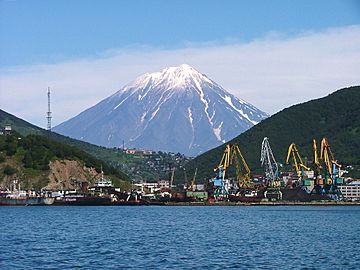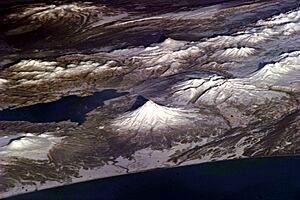Volcanoes of Kamchatka facts for kids
| UNESCO World Heritage Site | |
|---|---|

Koryaksky volcano rising above Petropavlovsk-Kamchatsky
|
|
| Location | Kamchatka Krai, Russia |
| Includes |
|
| Criteria | Natural: (vii)(viii)(ix)(x) |
| Inscription | 1996 (20th Session) |
| Extensions | 2001 |
| Area | 3,830,200 ha (14,788 sq mi) |
The volcanoes of Kamchatka are a huge group of volcanoes found on the Kamchatka Peninsula in Russia. This area is famous for having many volcanoes and related natural wonders. There are about 160 volcanoes in the region.
Out of these, 29 are still active, meaning they could erupt. These active volcanoes are part of six special areas. These areas are so important that UNESCO has listed them as a World Heritage Site group. Most of these amazing volcanoes are located right on the Kamchatka Peninsula.
Contents
Exploring Kamchatka's Volcanoes
The Kamchatka River flows through a central valley. This valley is surrounded by large areas filled with volcanoes. It's like a giant natural park of fiery mountains.
Kamchatka's Tallest and Most Beautiful Volcanoes
The highest volcano in Kamchatka is Klyuchevskaya Sopka. It stands at 4,750 meters (15,584 feet) tall. This makes it the largest active volcano in the northern part of the world.
Another very striking volcano is Kronotsky. Many experts, like the famous volcanologists Robert and Barbara Decker, have said it has the most perfect cone shape. They even called it a top choice for the world's most beautiful volcano.
The Famous Valley of Geysers
In the middle of Kamchatka, you can find the well-known Geyser Valley. A geyser is a hot spring that shoots water and steam into the air. This valley is a natural wonder. In June 2007, a large mudslide changed part of this valley.

Why Kamchatka Has So Many Volcanoes
Kamchatka has so much volcanic activity because of how Earth's plates move. Deep under the ground, the Pacific Plate is slowly sliding beneath another plate. This process is called subduction.
Earthquakes and Tsunamis
When these huge plates move and grind against each other, it causes many earthquakes. Sometimes, these earthquakes are very strong. For example, two very big earthquakes happened off the coast. One was on October 16, 1737, and another on November 4, 1952. These were very powerful, with magnitudes around 9.3 and 8.2. A magnitude number tells us how strong an earthquake is.
Sometimes, these strong underwater earthquakes can also cause tsunamis. Tsunamis are giant ocean waves that can travel across oceans. Smaller earthquakes have also happened more recently, like in April 2006.
See also
 In Spanish: Volcanes de Kamchatka para niños
In Spanish: Volcanes de Kamchatka para niños


